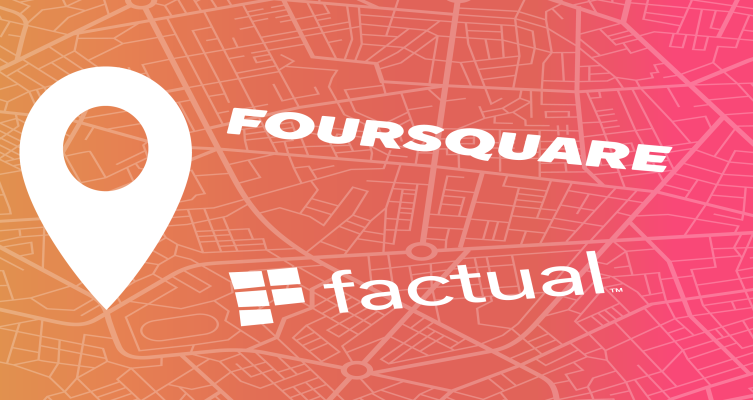Foursquare, the 10-year-old location platform based in New York City, has today announced its plan to merge with Factual.
The terms of the deal were not disclosed. The merged company will keep the Foursquare moniker, and Foursquare CEO David Shim will remain at the helm, with Factual’s founder and now-former CEO Gil Elbaz joining Foursquare co-founder Dennis Crowley as a member of the board and executive team.
Shim confirmed to TechCrunch that this merger was in the works before the coronavirus turned the world upside down.
A company spokesperson acknowledged that there are redundancies in the two teams — so there will be layoffs, although they declined to get specific about how many employees or which teams will be affected.
Foursquare is not the same company it was when it launched at SXSW in 2009. The location-based social network, which let people check in to locations to share with their friends and earn badges, has evolved over time into an advertising and marketing platform focused on location as a differentiator.
In 2014, Foursquare split its main app into two separate apps, the Foursquare City Guide and Swarm. Swarm let users check in to locations and earn mayorships and other stickers, with a focus on social utility that was eventually de-emphasized in favor of life logging. Foursquare City Guide, on the other hand, used past check-in data and data from Swarm to power a Yelp competitor, giving users a way to find great restaurants and experiences in their area.
Since that split, Foursquare has built out a back-end platform for brands and publishers to leverage its data, including an API and SDK for developers to offer location-contextual experiences to their end users. For example, Uber started using Foursquare’s tools to allow users to type in the name of the restaurant or store where they wanted to be picked up, rather than having to hunt down the physical address.
The Pilgrim technology, according to Foursquare, is more accurate than your average location tech because of its 10 years of check-in data. The tech understands the difference between a fifth-story location and a ground-floor location. It knows the difference between the coffee shop and the bar next door in a densely packed city like New York.
Because of this, Foursquare is able to give brands the ability to serve these hyper-contextual experiences in the right place at the right time. And it’s been relatively successful doing so.
Foursquare reported more than $100 million in revenue last year.
Factual, for its part, also launched in 2009 as a repository for open data, but over time it has become increasingly focused on using its location data to improve advertising. The company offered brands the ability to track the success of their marketing campaigns, measuring whether a campaign actually got people to visit stores physically — so you can see why it might be a good fit with Foursquare.
Factual’s Elbaz argued that there’s not only a huge opportunity in the location data space, but also a need to combat the threat posed by the digital ad “duopoly” of Google and Facebook. This is a sentiment that has been echoed by Foursquare, which says that a vertically integrated, solely location-focused company is better for data privacy than ad-first companies like Facebook and Google.
“Both companies have long maintained that there is a need for independent, neutral location data, available outside of the walled gardens, and we expect near-term that the walled gardens will relent and seek out an independent partner,” said David Shim. “Foursquare is primed to be that provider.”
Collectively, our biggest strength lies in trust,” added Gil Elbaz. “Marketers need an independent and neutral party they can trust, for measurement, for continuity, and for true innovation. This deal represents 30+ years of combined experience where we have been sought out as the independent, leading source for location.”
Prior to the merger, Factual raised a total of $104 million, most recently in a $42 million round with participation from Upfront Ventures and Felicis Ventures.
The combined entity will represent some of the largest location data sets in the world, spanning more than 500 million devices, a panel of 25 million opted-in, always-on users and more than 14 billion user-confirmed check-ins. The company will also have data on more than 105 million points of interest across 190 countries and 50 territories.
That said, combining forces might be more than just a good idea — it might be a necessity. A recent IAB survey found that 74% of media planners and brands are expecting the COVID-19 pandemic and resulting economic downturn will have an even bigger impact on ad spend than the 2008 recession. Add to that the fact that most people are (or should be) staying home and it’s looking like a challenging year for any location-based ad company.
“Generally speaking, there’s no denying that the entire advertising/marketing industry at large has taken a hit from COVID-19,” said David Shim. “We started seeing some impact in late-March. At the same time, it’s opened up new conversations from those who are looking to us to help them understand the impact COVID on their business, and brands are already working with us to prepare for the ‘Great Reset’ in offline consumer behavior.”
He added that there will be pent-up consumerism, making this “a historic opportunity to grab and defend market share.”










